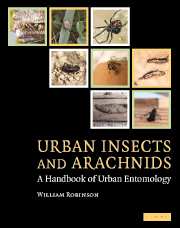Book contents
- Frontmatter
- Contents
- Preface
- Part I Urban entomology
- Part II Insects in the urban environment
- 4 Blattaria
- 5 Coleoptera
- 6 Collembola, Dermaptera
- 7 Diptera, Ephemeroptera
- 8 Hemiptera, Homoptera
- 9 Hymenoptera
- 10 Isoptera
- 11 Lepidoptera
- 12 Mantodea, Neuroptera
- 13 Orthoptera, Phasmatodea
- 14 Phthiraptera
- 15 Plecoptera, Psocoptera
- 16 Siphonaptera
- 17 Thysanoptera, Thysanura, Trichoptera
- Part III Other arthropods in the urban environment
- Family, genus, species index
- Index
- References
13 - Orthoptera, Phasmatodea
Published online by Cambridge University Press: 06 August 2009
- Frontmatter
- Contents
- Preface
- Part I Urban entomology
- Part II Insects in the urban environment
- 4 Blattaria
- 5 Coleoptera
- 6 Collembola, Dermaptera
- 7 Diptera, Ephemeroptera
- 8 Hemiptera, Homoptera
- 9 Hymenoptera
- 10 Isoptera
- 11 Lepidoptera
- 12 Mantodea, Neuroptera
- 13 Orthoptera, Phasmatodea
- 14 Phthiraptera
- 15 Plecoptera, Psocoptera
- 16 Siphonaptera
- 17 Thysanoptera, Thysanura, Trichoptera
- Part III Other arthropods in the urban environment
- Family, genus, species index
- Index
- References
Summary
ORTHOPTERA
Introduction
Members of this order include grasshoppers, crickets, and katydids. They are primarily plant feeders and distributed in all zoogeographic regions. They are characterized by having biting–chewing mouthparts, usually well-developed wings, with the fore wings enlarged or thickened; some are brachypterous, and some apterous. The body is elongate and the antennae are usually long. Development is gradual; the nymph stages resemble adults except for wings, when present. Egg and nymph stages survive dry seasons or overwinter.
Pest status is limited to a few domestic and peridomestic species in the urban environment. The house cricket, Acheta domestica, is the only species that occupies and reproduces indoors. However, other crickets frequently utilize household sites for harborage and foraging, or they are attracted to lights at night. The house cricket may damage materials, but other species are only a nuisance. Large numbers of field crickets can be a nuisance. In late summer large numbers may move to the perimeter of buildings during cool nights. The presence of these insects around and sometimes in the living space can contribute to respiratory asthma.
Acrididae
These are typical grasshoppers. They have short, thick antennae, and the front of the head is prolonged forward a little beyond the eyes. The pronotum has a well-developed median ridge. The terminalia of the female are small. These grasshoppers are active during the day; they feed primarily on living plants. Males stridulate during the day, and the females of some species stridulate.
- Type
- Chapter
- Information
- Urban Insects and ArachnidsA Handbook of Urban Entomology, pp. 350 - 358Publisher: Cambridge University PressPrint publication year: 2005

